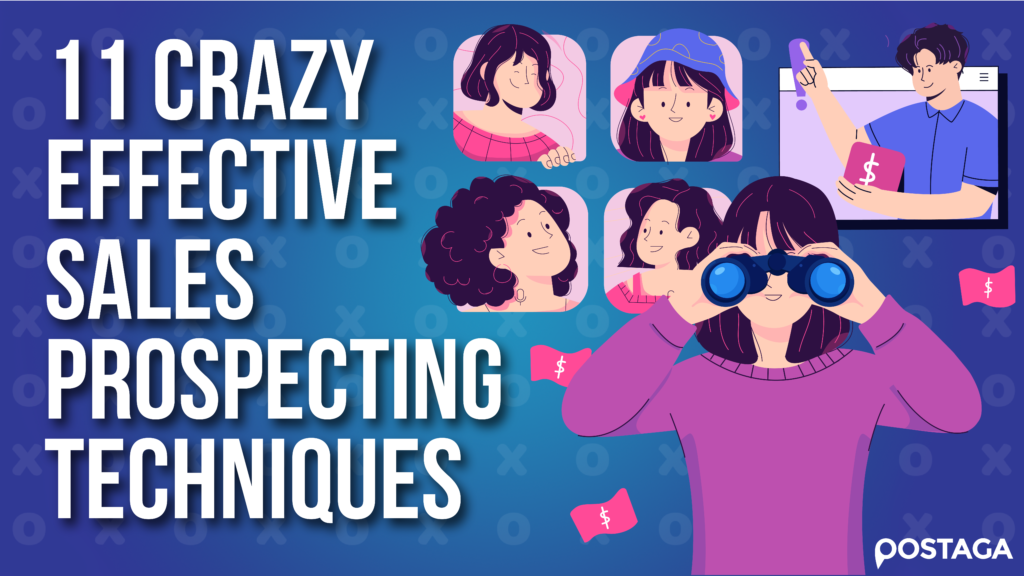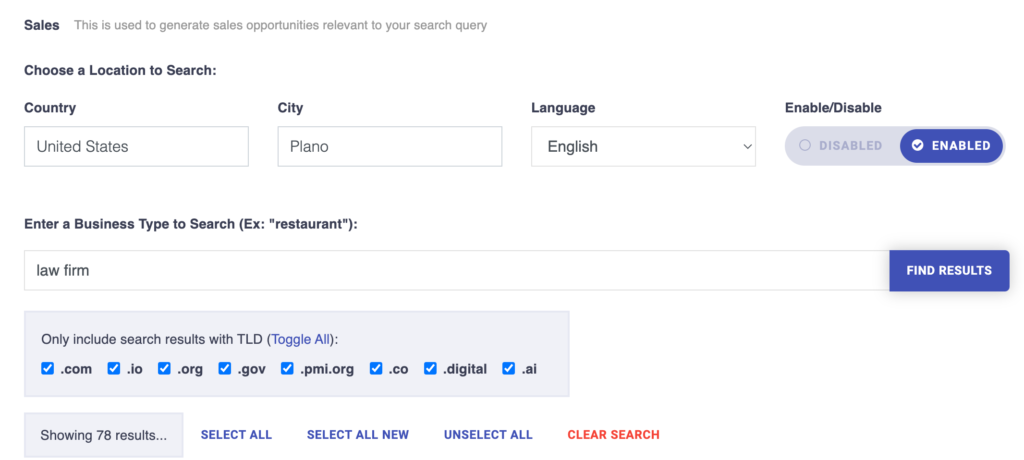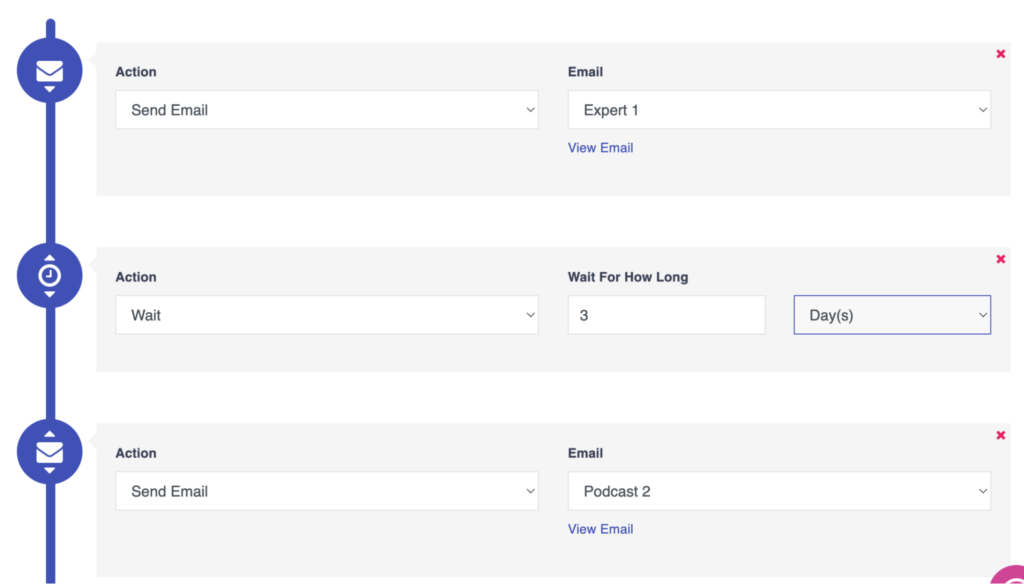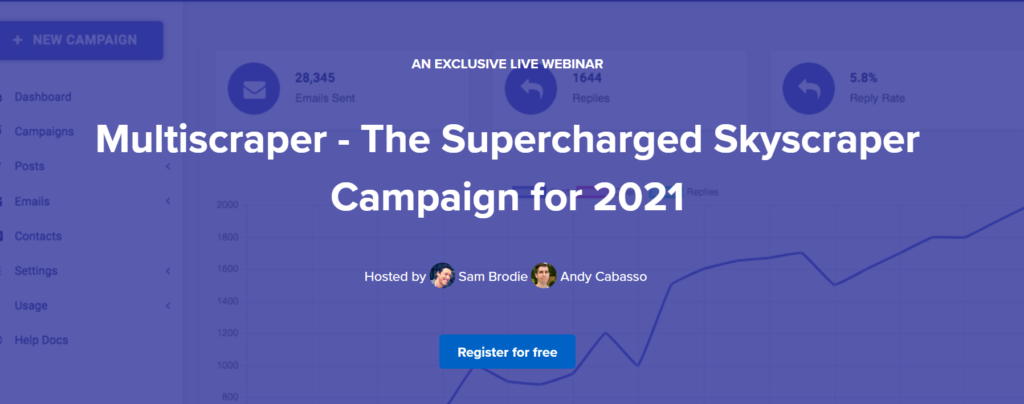
Everyone says that selling is hard. I disagree.
Selling, the actual act of talking to someone, presenting the benefits of your product, and getting them to sign on the dotted line is actually pretty easy.
Sure, you still have to do the work but at that stage, you have the biggest selling challenge far behind you.
You already have someone to talk to, email, or engage in any other way you prefer.
Before that, well, before that you have to prospect and find potential new customers, and that’s where the problem starts, right?
Prospecting is challenging. It’s hard to feel energized by the prospect of having to scout for new leads. Hell, sometimes it even feels a bit soul-crushing, right? There’s no point in denying that.
(It’s not just my opinion, by the way. According to this research by Hubspot, for instance, 40% of us consider prospecting to be the most challenging part of the sales process.)
The thing is – We’ve no choice. We have to prospect. We have to continuously identify new leads, and build lists of people to contact after another.
Well, there’s good news here too – There are ways to streamline the process, and in this post, I’ll share with you the 11 sales prospecting techniques I use to get the job done.
Intrigued to learn my tricks?
OK, let’s start with the heavy stuff, then.
Some hard truths about sales prospecting
This I’m sure you know already – Sales prospecting is a stage in the sales process that focuses on identifying potential leads.
When you prospect, you aim to generate a list of names that you could reach out to and begin the sales process with.
However, your ultimate goal is to use that list to generate a sales pipeline of qualified leads. This process starts with building the prospecting list, and continues with different sales outreach strategies – cold calling, email outreach, etc. – to engage and qualify those prospects, and convert some of them into leads.
Well, that’s the theory. There are, however, certain aspects of sales prospecting no definition will tell you. Coincidentally, these are the things that can have an enormous impact on your prospecting success.
So, let me be the one to spill the beans.
Hard truth #1. Prospecting is not a once-off effort.
I wish it was but nope. You cannot prospect every now and then, or run an occasional prospecting campaign here and there and win.
Why? Because no matter how long a list you’ll build, you’re going to run out of people to contact.
And the problem is that by then, you’ll have to spend time prospecting and building the list, instead of doing the stuff that makes the dough – Engaging with and working on your leads.
What you should do instead is dedicate time each week to prospecting. Even if you’re not going to be reaching out to those people you find immediately, you will have them on the list.
Here’s a quick data point to put this into perspective for you. 81.6% of top sales performers spend 4 hours or more PER DAY (!!!) on sales-related activities like prospecting. That’s what drives their success, actually.
Hard truth #2. Prospecting isn’t about quantity.
But I admit that it might seem otherwise, at first. Your goal is to find as many relevant prospects, after all. Wouldn’t it make sense to build an as long list of prospects as possible?
No. You see, the key phrase in what I said above wasn’t “as many.” It was “relevant.”
Sure, a whole bunch of prospects or leads sounds amazing. But if these people don’t match your ICP and are never going to convert, then what’s their value to you?
A shorter list but filled with people who are looking for products and services like yours, need those now and have the money to pay, on the other hand, is priceless.
Hard truth #3. You can automate sales prospecting.
Don’t get me wrong, you still have to do the work. But you can greatly shorten the process, and generate more prospects at scale with various prospecting tools.
These tools can help you save a lot of time by streamlining many repetitive tasks, providing you with more data and insights to qualify leads faster, and even delivering those people’s contact details.

What does the prospecting process look like
I suppose you could say that there are two approaches to prospecting.
One is all about just scouting the web, LinkedIn, and other data sources for a list of potential customers to reach out to. I think of it as a wild ride of prospecting. You just go and do it, without thinking too much about it, grab some names, and begin to sell.
Well, I don’t like that method. Sure, it might generate some results but in reality, it’s like shooting in the dark.
The other approach is to follow a system and that’s the method I fully support and use.
Here’s what this process looks like in general when it comes to B2B sales.
First, you research prospects. Determine whom you’d like to connect with, and also, how you could provide value to those people. At this stage, you also begin the prospecting process and build the initial list of names and contacts to engage.
Next, you grade names on your list. Consider this step as an additional check to determine whether the person matches your ICP and could become a customer. You can also prioritize your prospects to see whom to reach out to first, and so on.
Reach out with a strong introduction. Send your prospects a sales introductory email to kick-start the conversation. Or use the first phone call to the prospect to tell them about your business and product, and build the initial rapport.
Follow up, and keep doing that until you hear back or exhaust your sales cadence. One research study after another proved that we gave up too much. So keep following up.
Add leads to your CRM. Basically, whoever responds positively to your outreach is a lead. Move them to your sales process, schedule a call or presentation or follow whatever steps you normally do in the process.
And here are sales prospecting techniques that will help improve all of those elements of the process.

11 crazy effective sales prospecting methods I know to be working
#1. Build your brand and expert status
Let’s start with something I consider a foundation for successful prospecting. It’s so much easier to engage prospects when they already perceive you as an expert or a thought leader. Or if that’s the image of you they get when checking you out online. It’s much easier for them to decide to respond to you if what they find – your content, social media posts, and other information you’ve shared – presents you as someone who knows their stuff.
Building your brand is also a way to stand out from other sales professionals, who choose not to share their expertise, and in the process, remain nameless to their prospects.
How to build your brand and thought leadership? The simplest way is to share your knowledge and expertise. Write blog posts on your company’s site. Publish on relevant industry publications. Speak at trade shows. If you’re not mic shy, launch a podcast.
In general, create content that addresses your audience’s pain points, and share your expertise anywhere where your prospects might find it.
TIP: Let me share with you another benefit of creating all this content. It can help you address sales objections while presenting you as the expert. This is what I do, by the way. Every time a potential customer asks me a “tough” question, I answer but also, point them to an article on the topic on our site.
#2. Block time for prospecting every week
And I don’t mind that you decide to work on prospecting every week. No.
I’m talking about setting aside time in your calendar dedicated only to finding new prospects and building prospecting lists.
Decide when you’ll be prospecting each week, and block that time off your appointment scheduler and other calendar apps. Make this time all about prospecting. Don’t let anyone book anything else for you then.
With that, you’ll always have prospects to reach out to, and slowly create a steady pipeline of relevant leads and deals.
#3. Spend time crafting (and updating) your ICP
You know – Picking a target market or audience is easy. But it doesn’t mean that you know enough about those people to find and engage them.
Quite the contrary, in fact. In such a scenario, you’d be, most likely, working off many assumptions and incomplete data. Granted, your assumptions might be correct. But might also be not.
Instead, spend time researching your ideal customer profile. Find out as much as you can about them. Your research should also include information about problems and challenges that force your target audience to search for solutions that you sell.
This will help you develop a very precise prospect profile, and ensure that your outreach is always on target.
#4. Understand your best customers to reach your best prospects
I know that this technique may sound like a mouthful but let me explain. When prospecting, you want to reach the best people possible, those who offer the greatest opportunity to become customers.
One challenge you experience with that is figuring out who those people are, of course. We’ve discussed that in the two prospecting strategies above.
Another is where to meet them, right? So let me show you a simple hack to help you figure this out.
Look at your best customers. Think about how you found them, how you met them, or where you came across their profiles. The chances are that you’ll find similarities among them. Maybe your best clients come through referrals (and maybe it’s the same group of people who referred you to them.) Or maybe you always connect with the best leads at trade shows. Maybe those people followed your organization on social media. Or perhaps you’re all connected to the same person on LinkedIn.
Whatever that source (or sources) of best leads is, it’s where you should be. If its referrals, make sure that you stay on top of mind with whoever referred you to those people. Depending on your relationship with that person, you may even ask them for some additional referrals. If it’s LinkedIn, increase your presence there. Share more content and expertise, engage with people like your best clients there, etc.
#5. Use software to build prospecting lists automatically
I have to be upfront here – I may be a little biased with this strategy. One of the features of my software – Postaga – is prospecting.
The tool lets you search for potential prospects using several different criteria and returns a list of names and email addresses to use for email outreach.
Here’s what the search feature looks like:

(Prospecting tool in Postaga)
With this feature, you and your sales reps can quickly build prospecting lists for cold email campaigns, and begin reaching out to those prospects.
Want to improve prospecting and outreach strategies? Check out how Postaga can help. Sign up for a free trial now.
#6. Develop (really) long follow-up cadences
At this stage, it’s more than official: We salespeople give up too quickly. There’s plenty of data to prove it.
According to this site, 48% of salespeople never make even a single follow-up attempt! It’s crazy. At the same time, 80% of sales require at least 5 follow-ups (and 44% of those sales teams that do follow-up, give up after the first attempt.)
I know from experience that unless you continue following up, your conversion rates will never become anything to boast about.
Naturally, the optimal number of follow-up emails will vary depending on your product, target audience, and countless other factors. But my recommendation is to keep the cadence long. Really long. Don’t stop after the fifth email just because you didn’t get a reply.

(An example of a follow-up cadence set up in Postaga)
TIP: In my guide to creating sales follow-up cadences I recommended setting up at least 8-12 follow-ups. You can read the whole guide and discover why here.
#7. Write a striking introduction email
A sales introductory email is the very first message you send to a prospect to tell them about yourself, your product, or the business. The message, typically, starts your cold email strategy, after which you send different follow-up emails.
The purpose of the intro email is to initiate a professional conversation with your prospects. Unfortunately, that’s also what makes writing those messages so difficult.
TIP: Check out my guide to writing sales intro emails and learn how to introduce yourself and your product in the initial email you send to prospects. I’ve also included some email templates that you can tweak and use in your campaigns.
#8. Ask for referrals
This is one sales prospecting technique that might be hard to scale but delivers insanely great results. The technique is to ask new customers for referrals to people like them. The logic behind it is that if you’ve connected well with the person, the chances are the same will happen with the people they know.
How to ask leads for referrals? It’s simple, actually. After you’ve closed the sale, ask your new client whether they can think of anyone in their network who could benefit from your products or services too. Don’t be pushy. If a prospect says that they can, ask if they’d be willing to introduce you to them.
#9. Build your social media presence
I usually get a wince or two when I talk about the importance of social media in sales. Yet, the facts are clear. Most of us are on social media. And even if we’re not actively using Twitter, Facebook, or LinkedIn, we research people we want to do business with there.
And so, being on social media, even if you’re not incredibly active there, will help you be where your potential customers might be. You can share your content with them there, and build your expert status too. What’s more, you can monitor the industry and your key target accounts, and use your findings to build rapport.
In fact, the opportunities to use social media in sales are practically endless.
#10. Host a webinar
Oh, I absolutely love this prospecting strategy. I use it often too.
Here’s just one example of a webinar my co-founder and I run recently.

This prospecting technique is so powerful because not only it allows you to find new potential clients, but you also qualify them with it.
I’ve never met anyone who’d attend a webinar on a topic they didn’t have any interest in. So, you can safely assume that your attendees care about what your webinar is about, and most likely, need help with that thing too.
TIP: Ask people who’ve attended your webinar whether they’re interested in learning more about your product or services. You might need to follow up with them a couple of times but overall, you’ll be surprised how many will agree to a demo!
#11. Use a multi-channel approach to outreach
You know, usually, when we think of outreach, we have a single strategy in mind.
So, we think of reaching prospects with cold calling, email outreach, or social media outreach. But we rarely think of using all three in a single campaign.
At the same time, when you go beyond just one strategy, your chances of reaching a prospect increase significantly. Your prospects might ignore the first email (or even some follow-ups) but might take your call. Or spot your message on social media, and only go back and read your emails then.
In short, a multi-channel means that you’re increasing the chances of your message reaching the prospect exponentially.
Granted, I’d still recommend you choose one primary channel. This will be the main strategy you’ll use when outreaching. However, you can then bake other channels into the sales cadence to capture the prospect’s attention.
And that it…
Now you know the 11 sales prospecting techniques countless salespeople and I use to find, connect with, and engage potential customers.
Naturally, you don’t have to use all those techniques. Pick the ones that you feel comfortable with, and run with them. Because ultimately, it’s all about just doing the work, right?
Good luck!
Free 14-Day Trial
Start building relationships now with your fully-featured 14-day trial!
How We Compare
Terms | Done-For-You Terms | Privacy | Write For Us | Press
© 2025 Postaga. All Rights Reserved. Made with 

